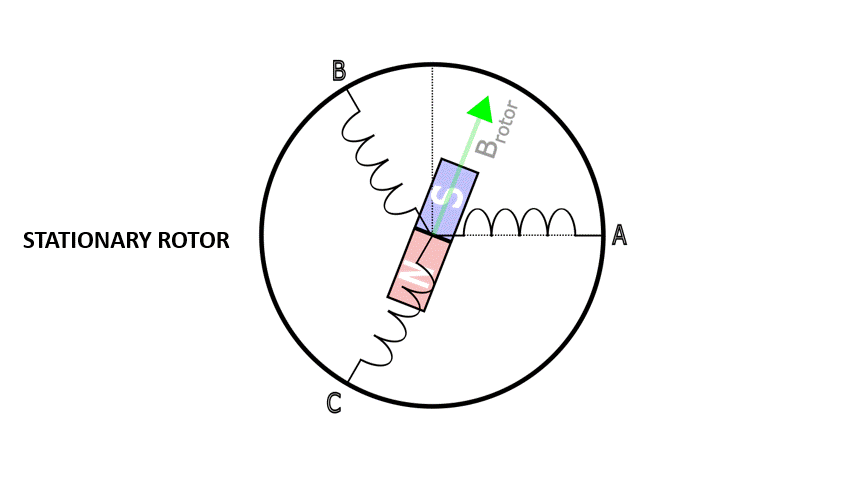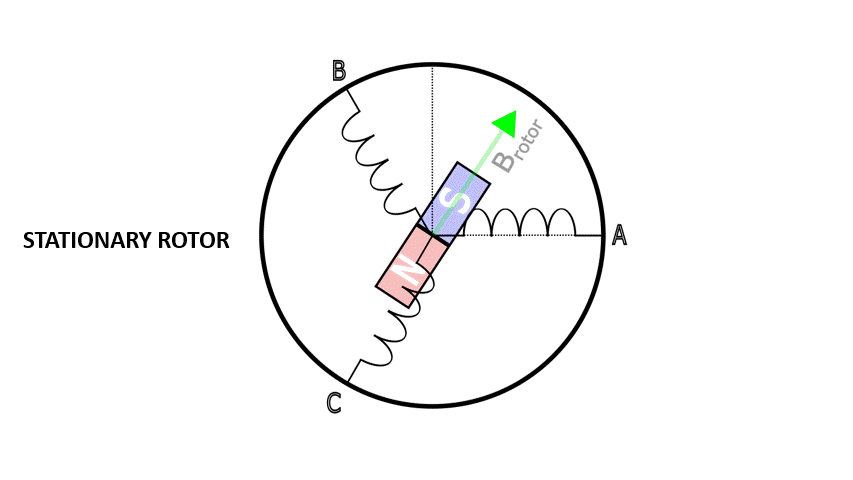startup methods for sensorless motor control
To run a BLDC motor, the rotor position is needed so that the stator field can be set orthogonal to the rotor field. Most sensorless motor controllers rely on the back-emf generated in the stator winding to obtain the rotor position. Back-emf is generated only when the magnetized rotors are moving. So when the rotor is at rest, there is no back-emf generated, and the rotor position cannot be inferred. Thus, motor controllers implement a startup method for sensorless control.
Open loop startup
In open-loop startup, the controller generates a rotating magnetic field by forcing current in the stator winding. The generated magnetic field is not orthogonal to the rotor field but still generates some torque to rotate the rotor. After the rotor reaches sufficient speed to generate back-emf, the controller can measure the rotor position and start field oriented control.
 |
|---|
| Open loop startup method. A rotating magnetic field is generated by the controller and the rotor rotates with the field. After the rotor reaches sufficient speed to generate back-emf, the controller starts FOC |
The controller generates a rotating magnetic field without knowing the rotor position. So the generated magnetic field is not orthogonal to the rotor magnetic field. The torque generated during this process is thus inefficient.
There are 2 common open-loop startup technique: V/F startup and I/F startup
V/F startup
One common method to implement this is V/F startup. In V/F startup, the controller generates a 3-phase sine wave voltage to the motor which generates a 3-phase current and a rotating magnetic field. The voltage and frequency is increased linearly until the motor accelerates to sufficient speed.
I/F startup
In I/F startup technique, the controller directly controls the 3-phase current through its current controller to generate a rotating magnetic field. I/F technique accelerates the motor to sufficient speed at a constant torque. When the starting under load, the I/F technique provides better performance due to its torque regulation abilities.
Rolling-start/windmilling
Rolling start method waits for the rotor to be rotated by an external torque. After the external torque brings the rotor to sufficient speed, the controller detects the rotor position and delivers torque. This technique is also called windmilling.
 |
|---|
| Rolling start method. An external torque rotates the rotor and the controller delivers torque after the rotor reaches sufficient speed |
Rolling start works best in torque control mode, where the controller regulates the Iq current.
Rolling starts for ebikes
A common application of rolling start is in sensorless control of direct-drive HUB motors for ebikes. The ebike is gently moved forward and the controller delivers torque after detecting the wheel rotation.
Compared to the open-loop startup method, this method reduces the starting current and stress on the battery.
Saliency tracking
In some motors, the inductance of a coil varies as a function of rotor position. This variation is due to the rotor geometry. Saliency tracking exploits this variation in inductance to estimate the rotor position.
This method of rotor position detection does not depend on the back-emf. So the rotor position can be detected even at zero speed, and the controller can generate torque at standstill.
Read more about Saliency tracking here